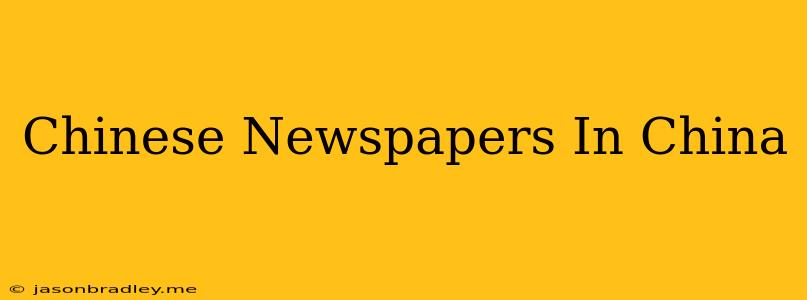Chinese Newspapers in China: A Dynamic Media Landscape
China has a vast and dynamic media landscape, with a multitude of newspapers playing a significant role in informing the public. While the internet has become a major source of news, printed newspapers still hold substantial influence in Chinese society, particularly among older generations.
Types of Chinese Newspapers
Chinese newspapers can be broadly categorized into:
- Party-affiliated newspapers: These newspapers are affiliated with the Communist Party of China (CPC) and often reflect the official stance on various issues. They are known for their authoritative voice and reach a wide audience. Renmin Ribao (People's Daily), the official newspaper of the CPC, is the most influential newspaper in this category.
- State-owned newspapers: These newspapers are owned by the state and are usually more diverse in their reporting compared to party-affiliated newspapers. They cover a broader range of topics, including business, culture, and sports.
- Private newspapers: While less common than party-affiliated or state-owned newspapers, private newspapers are gaining traction in China. They offer a platform for independent reporting and often focus on specific areas of interest like business, technology, or entertainment.
Key Characteristics
Chinese newspapers are characterized by:
- Government oversight: The Chinese government exercises significant control over the media, and newspapers are subject to strict censorship guidelines. This means that sensitive topics like politics, human rights, and social unrest are often not covered or are presented in a way that aligns with the government's narrative.
- Focus on national issues: Most newspapers prioritize reporting on national news and policies, reflecting the emphasis on national unity and development.
- Traditional format: While some newspapers have embraced digital platforms, many maintain a traditional print format, with a focus on lengthy articles and detailed reporting.
Impact and Influence
Despite the rise of online media, Chinese newspapers continue to shape public opinion and influence the national discourse. They are a vital source of information for many citizens, particularly in rural areas where internet access is limited.
Moreover, newspapers play a crucial role in promoting national ideology and strengthening social cohesion. Their coverage often reflects the government's agenda, reinforcing its authority and legitimacy.
Challenges and the Future
Chinese newspapers face several challenges, including:
- Declining readership: The rise of online media has led to a decline in newspaper readership, particularly among younger generations.
- Competition from digital platforms: The internet offers a faster, more accessible, and often more diverse source of news, making it difficult for newspapers to compete.
- Financial difficulties: Many newspapers are struggling financially, as advertising revenue dwindles and subscriptions decrease.
Despite these challenges, Chinese newspapers are adapting to the changing media landscape. Many newspapers are expanding their online presence and experimenting with new formats and content to attract younger readers. While the future of traditional print media remains uncertain, Chinese newspapers are likely to continue playing a significant role in the country's information ecosystem.
